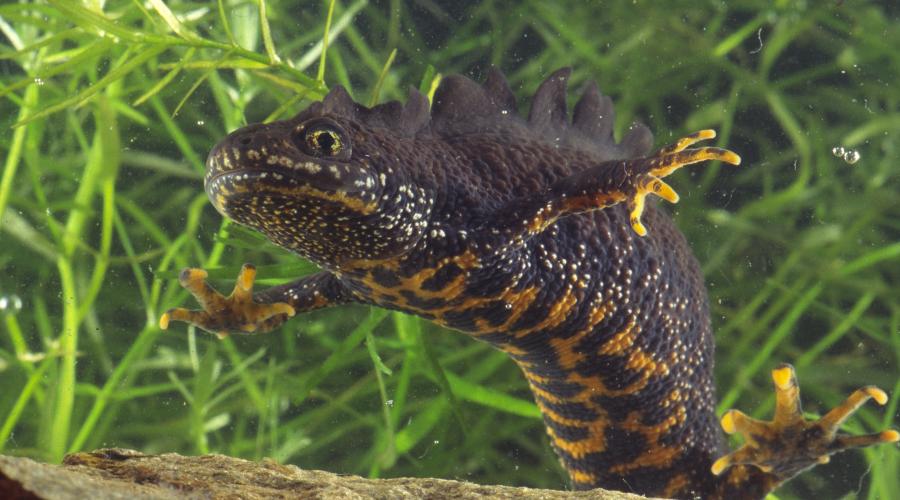
Scotland’s native reptiles and amphibians
Six species of amphibian occur naturally in Scotland, and three common species of reptile are found naturally on land.
We are looking for landowners, crofters, land managers, and farmers to take part in the national adder survey! Click the link above to find out more information.
Six species of amphibian, and three species of reptile can be found in Scotland, along with several introduced species. Amphibians and reptiles are important parts of our ecosystem here in Scotland, as a crucial source of food for other species, and as predators of pest species such as bugs. Find out more about these fascinating creatures below.
Our native amphibians
Common frog
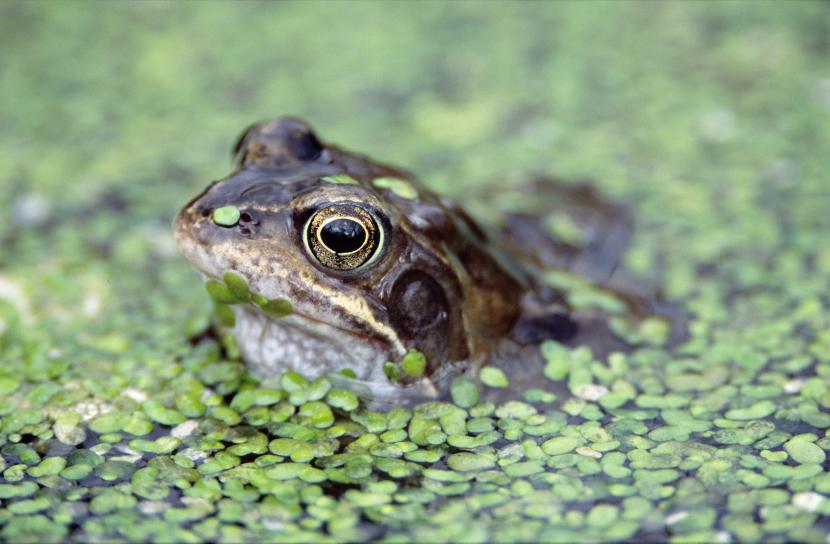
Common frogs (Rana temporaria) are thought to be a widespread species in Scotland, and can even be found at high elevations including mountains. They are also widespread on many of the islands, including Orkney and Shetland.
They inhabit a wide range of habitats including gardens, parks, farmland, lowland mosses and upland areas.
You can hear male common frogs calling at night during the spring breeding season, Males will grab onto females around their waist with fleshy patches on their thumbs known as ‘nuptial pads’. This is known as amplexus.
Common frogs will eat a wide variety of invertebrates such as worms, flies and moths, and slugs and snails.
Common toad
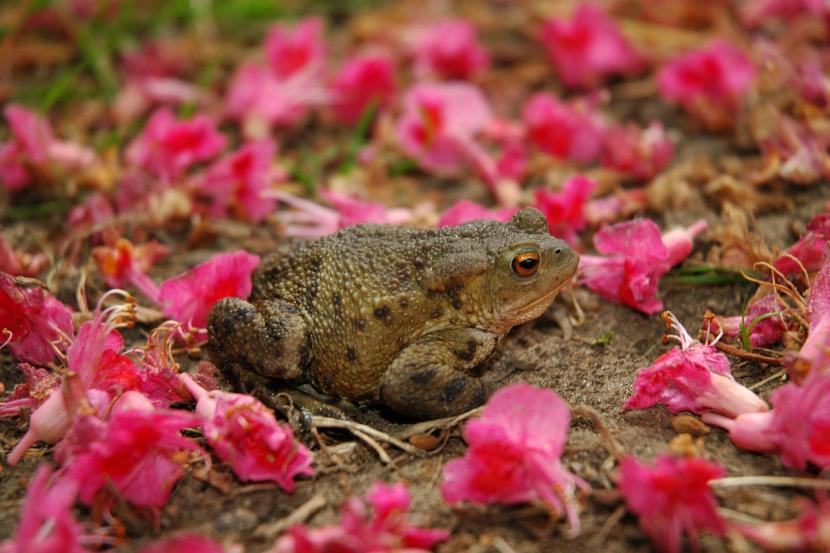
Common toads (Bufo bufo) are thought to be a widespread species across Scotland, including several of the islands such as Orkney, Mull, Skye, and Arran. They have also been introduced to several other islands.
They can be found in a wide range of habitats such as garden ponds, agricultural land, forest clearings, and upland moors.
Males can be heard calling during the breeding season, with multiple males attempting to mate with each female forming ‘mating balls’.
Common toads and their larvae are unpalatable to most predators due to toxins found in their skin.
Their diet consists of a wide range of invertebrates, such as beetles, spiders, springtails, and millipedes.
Natterjack toad
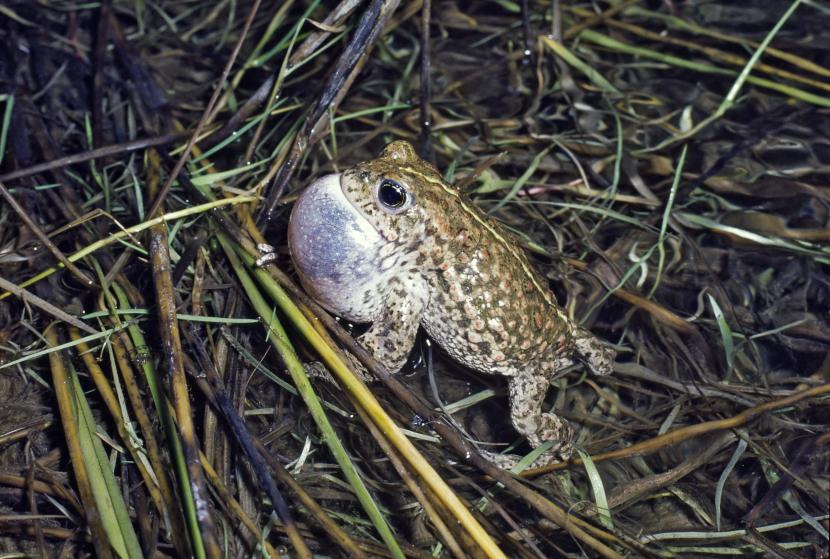
Restricted to a few sites on the Solway Coast in Dumfries and Galloway, the Natterjack toad (Epidalea calamita) is Scotland's rarest amphibian. These sites in Scotland are the most northernly part of its range in the UK.
Natterjack toads can be distinguished from common toads by a yellow stripe down the back. Common toad tadpoles are also all black, whereas natterjack toad tadpoles have a white spot on their chin.
The natterjack toad is a very active species, adapted to life on open sandy heaths and coastal grasslands where it hunts at night by running after prey rather than sitting in ambush and jumping like frogs and common toads.
Unlike other British amphibians, it can dig its own burrow in the sand to avoid the heat of the day. As it can be found on the coast, this species is also adapted to tolerate more saline environments compared to common frogs and toads.
They can be heard calling during the breeding season, with their call being likened to a rasping ‘fishing reel’ noise. This call can be heard up to 1km away.
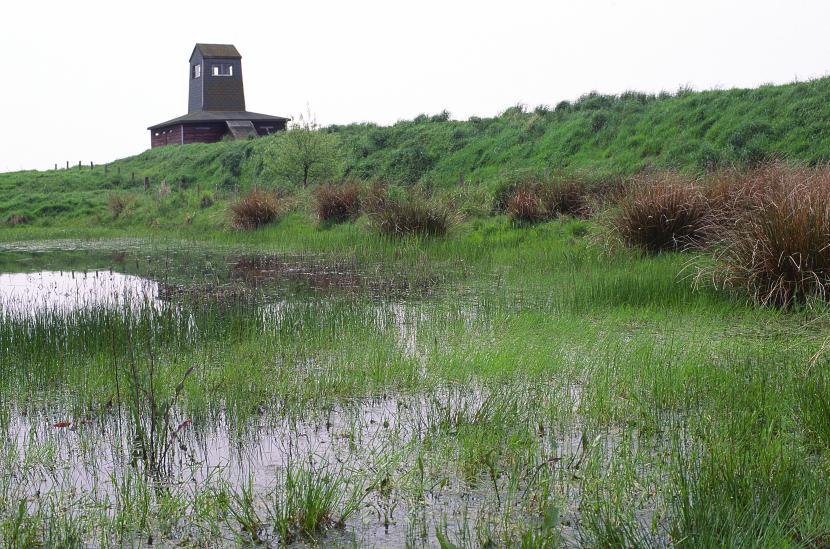
Threats to Natterjack Toads
As natterjack toads are only found in one small area of Scotland, it is important to preserve the habitat they have.
In 1976, a survey at Caerlaverock Merse counted approximately 2000 adults. However, since 2006 no Scottish population surveyed has produced even 100 individuals.
Threats to natterjack toads include:
- Loss and fragmentation of habitat through development works and coastal erosion
- Poor land management
- Climate change
- Disease
- Introduction of non-native species
Protection of natterjack toads
The natterjack toad is a European protected species.
Find out about protected species of amphibian and reptile.
Learn about licensing for great crested newts and natterjack toads.
Great crested newt
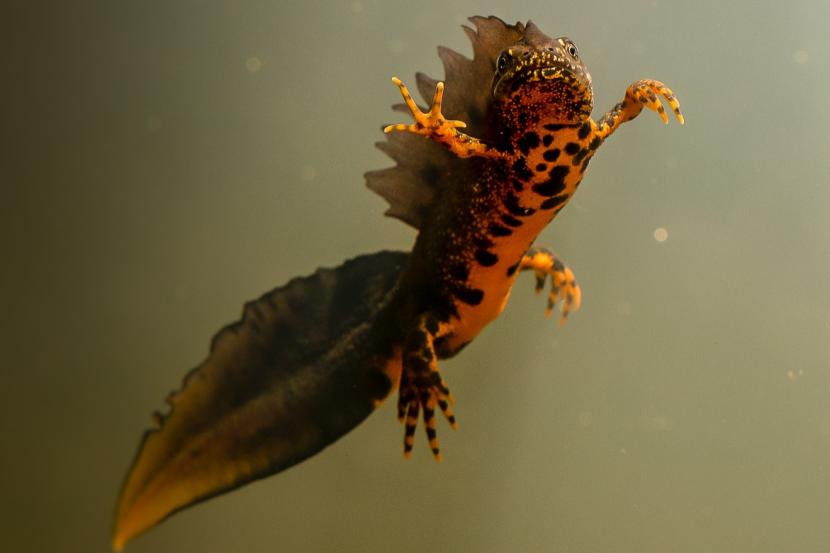
The great crested newt (Triturus cristatus) is the largest of Britain’s three newt species, with adults reaching up to 17cm in length.
This amphibian gets its name from the jagged crest along the adult male’s back, which gets larger in the breeding season. Both sexes are very dark in colour, with a vivid orange belly with irregular black spots.
The great crested newt spends most of its life on land, though it must return to small freshwater ponds to breed. This species hunts invertebrates by night, and rests in damp grassland or leaf litter during the day. It usually lives within 250m of a breeding pond.
Rare across Europe but still quite widespread in Britain, the great crested newt is found in Scotland in patches in the rural south and around Inverness. The species also occurs across the central belt, where it’s often under threat from industrial or housing development. This is because the newt has found a niche in former mineral workings and other brownfield habitats.
Breeding takes place in ponds in spring to early summer, when it’s warm enough. A female can lay around 300 eggs, one by one, on vegetation. Larvae usually develop in the pond for three months before moving to land. Once on land, the young take around three years to reach breeding maturity.
Threats to great crested newts
The species has suffered a decline in recent years and is under threat in several European countries. The British great crested newt population is amongst the largest in Europe.
Great crested newts thrive where several ponds within an area are connected by suitable habitat. This means that if one pond becomes unsuitable, others are still available for breeding.
A 1995-96 national survey found 85 ponds in Scotland with great crested newt populations. Subsequent conservation work has brought this number up to around 160 ponds.
Threats to the great crested newt include:
- Loss of breeding ponds through destruction or degradation of water quality
- Introductions of fish to breeding ponds – this is almost always catastrophic as fish will eat newt eggs and juveniles (as well as those of other amphibian species)
- Loss and fragmentation of terrestrial habitat
- The natural process of succession in which the pond, through time, fills with vegetation and silt and so dries out
Protection of great crested newts
The great crested newt is a European protected species.
Find out about protected species of amphibian and reptile.
Learn about licensing for great crested newts and natterjack toads.
Palmate newt
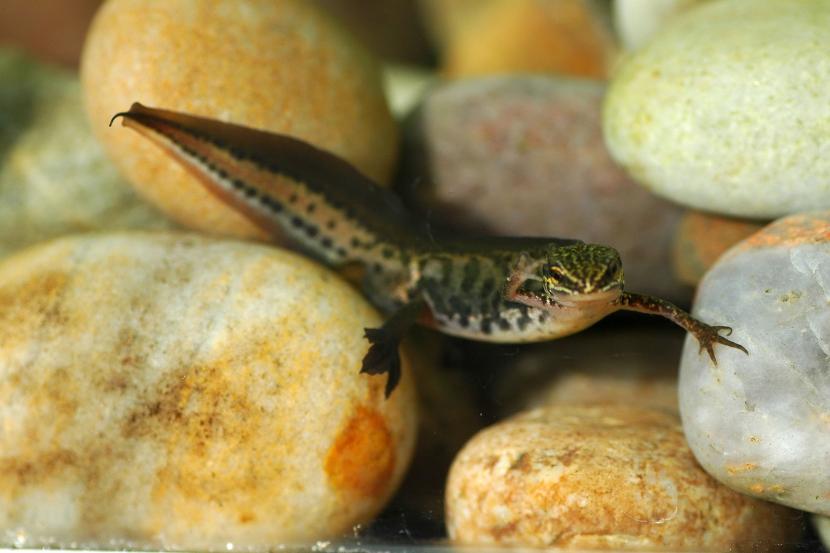
Palmate newts (Lissotriton helveticus) are found all over Scotland, including many of the islands, and at higher altitudes.
They can be found in a wide range of habitats such as woodland, heaths, grasslands, agricultural land, and urban areas.
The colour of individuals can vary between olive green, dark brown, with dark spots. They can be most easily distinguished from smooth newts by the presence of a pink, translucent throat. In their terrestrial stage, they have a yellow stripe down the back which continues down the tail.
Juvenile newts are aquatic with frilly external gills. These gills will be absorbed, and they will then leave the water and become terrestrial. They will then return to the water to mate during the breeding season.
Juveniles and aquatic adults will feed on zooplankton, Daphnia, frogspawn, and tadpoles, and terrestrial adults will eat slugs, springtails, and other small land invertebrates.
Smooth newt
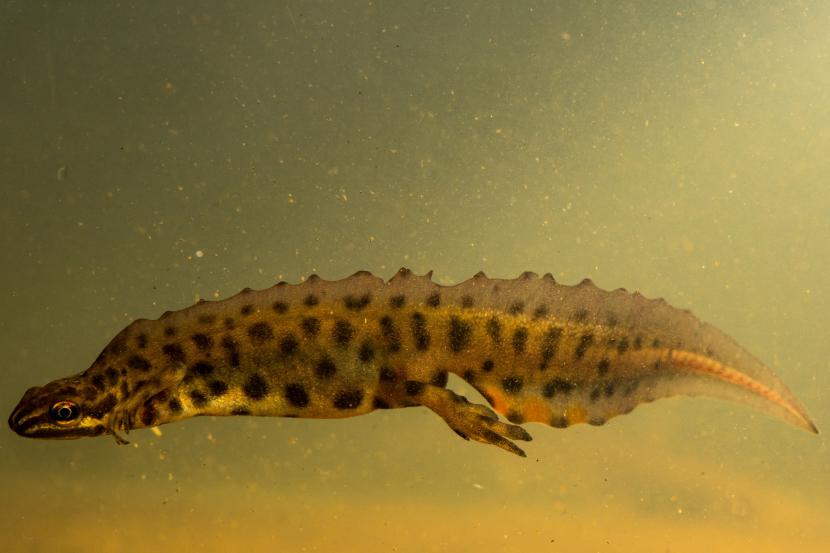
Smooth newts (Lissotriton vulgaris) are predominantly found in southern Scotland, with a few populations in the west of the country and the Highlands.
They can be found in lowland agricultural and urban areas, but are typically absent in areas of higher acidity, such as moors and mosses.
Smooth newts possess spotting on the belly, back, and throat, with breeding males developing a prominent dorsal crest. They can be most easily distinguished from palmate newts by the lack of a pink, translucent throat. In their terrestrial stage, they have a yellow stripe down the back which fades.
Juvenile newts are aquatic with frilly external gills. These gills will be absorbed, and they will then leave the water and become terrestrial. They will then return to the water to mate during the breeding season.
Juveniles and aquatic adults will feed on zooplankton, Daphnia, frogspawn, and tadpoles, and terrestrial adults will eat slugs, springtails, and other small land invertebrates.
Our native reptiles
Adder
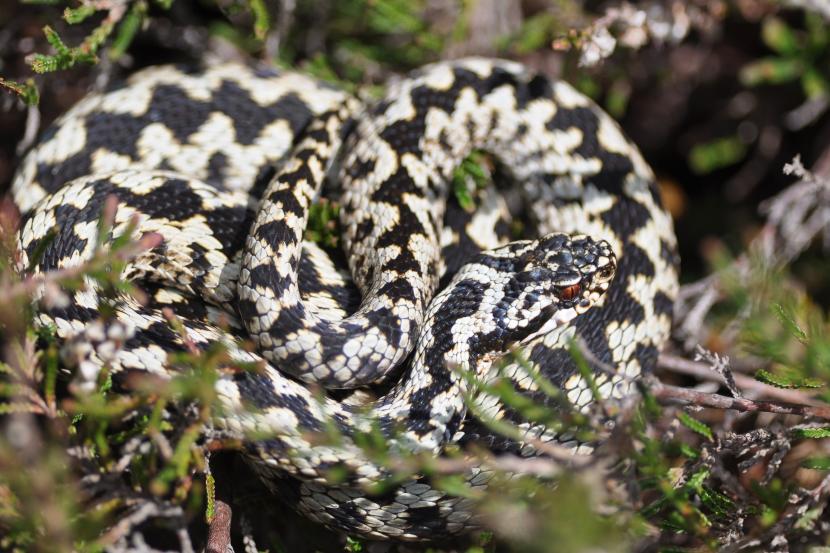
Our only native snake is the Adder (Vipera berus).
Adders put on an impressive display in the breeding season, although humans don’t often see it. The ‘dance of the adders’ is a form of a wrestling match between males competing for a mate.
In this display, two adders twist around each other, rising higher and higher, with each trying to force the other to the ground. The dominant animal wins the female and has the opportunity to breed with her.
While it is true that adders are venomous, these beautiful animals are generally elusive and rarely bite humans. An adder’s preferred method of defence is to hide away in the undergrowth.
Bites, including to livestock and pets, are largely due to disturbance, and so it is recommended that adders are left alone and only dealt with by experienced herpetologists. If you find one in the wild, let it move away quietly of its own accord.
However, if a bite does occur, the most common symptoms are swelling and discomfort. Medical assistance should still be sought out as soon as possible, as allergic reactions are possible.
Protection of adders
Find out about protected species of amphibian and reptile.
Common lizard
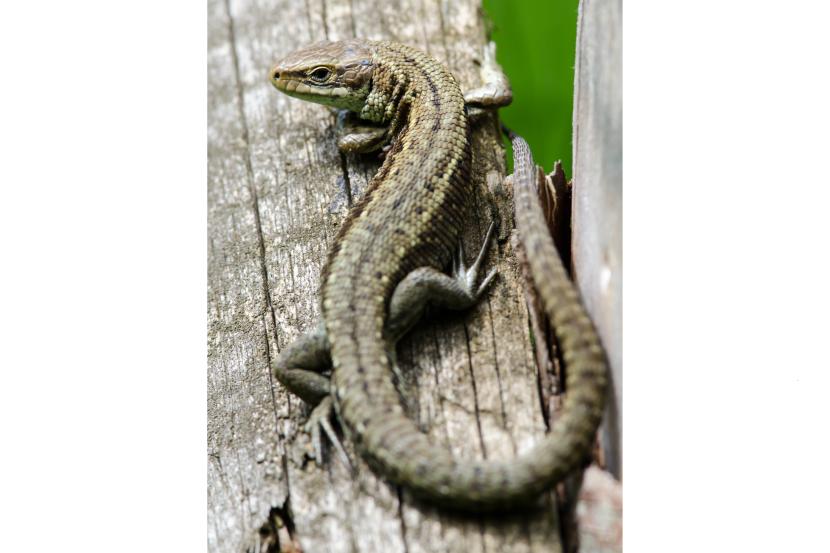
Common lizards (Zootoca vivipara) can vary in colour, with individuals varying from brown, to grey, to green. They could be confused with sand lizards, although in Scotland these are only found in one introduced population on the island of Coll.
This species is also sometimes known as the viviparous lizard as animals found in cooler parts of its range (including Scotland) give birth to live young.
During the mating season, males will chase and bite females, and will fight other males where encountered.
Common lizards often like to bask in open spaces warming up in the sunshine, and can often be heard scurrying into the undergrowth when disturbed.
When trapped or afraid, the common lizard is able to shed part of its tail, leaving it wiggling in the path of a predator as a distraction while the animal makes its escape. The animal can regrow the tail and perform the same display again if needed.
The species is less common in the Central Lowlands and isn’t found at all in the Northern Isles.
Scotland's only native legged reptile is the common lizard.
Protection of common lizards
Find out about protected species of amphibian and reptile.
Slow worm
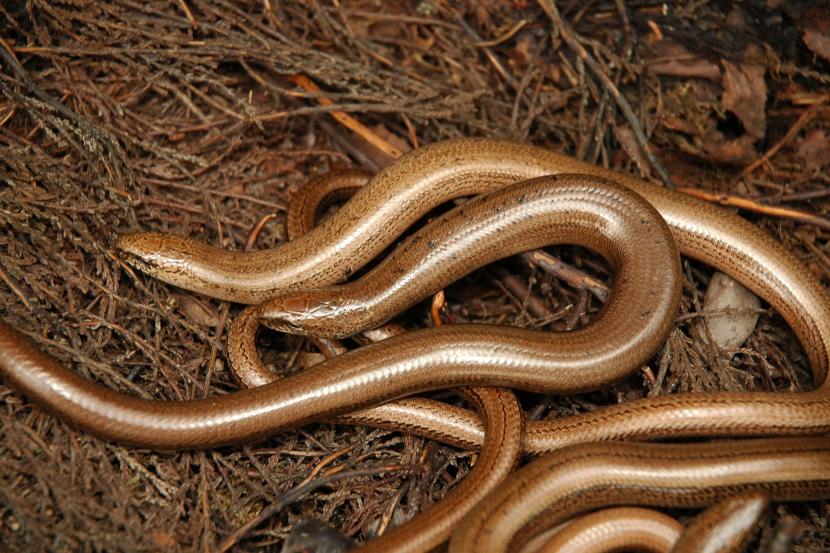
The slow worm (Anguis fragilis), despite its appearance, is actually a legless lizard rather than a snake. They have a wide distribution across Scotland.
Slow worms rarely bask in the sun. Instead, you can look for them under:
- Stones
- Wood
- Compost heaps
- Refugia such as sheet metal left lying around
Slow worms are often found using places made by humans such as embankments, churchyards, gardens. The slow worm is quite common across Scotland, and it is the only reptile known to occur in the Outer Hebrides. Slow worms can live 15 years or more in the wild.
Domestic cats are often responsible for fatalities, along with other introduced species such as rats and pheasants.
Their natural predators include birds of prey and larger mammals like badgers and foxes. Juveniles are sometimes predated by smaller bird species such as blackbirds.
Protection of slow worms
Find out about protected species of amphibian and reptile.
Species introduced to Scotland
Alpine newts
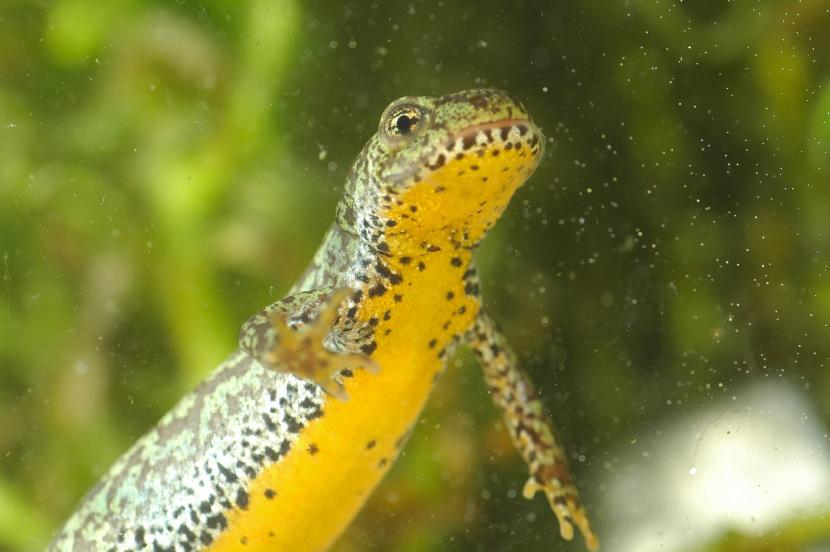
Alpine newts (Icthyosaura alpestris) are a non-native species that has established a few populations in Scotland, mainly in the Edinburgh area.
They can be identified through their blueish-grey skin and bright orange belly.
As they are invasive, if they are caught, it is an offence to release them back into the wild without the appropriate licence.
Sand lizards
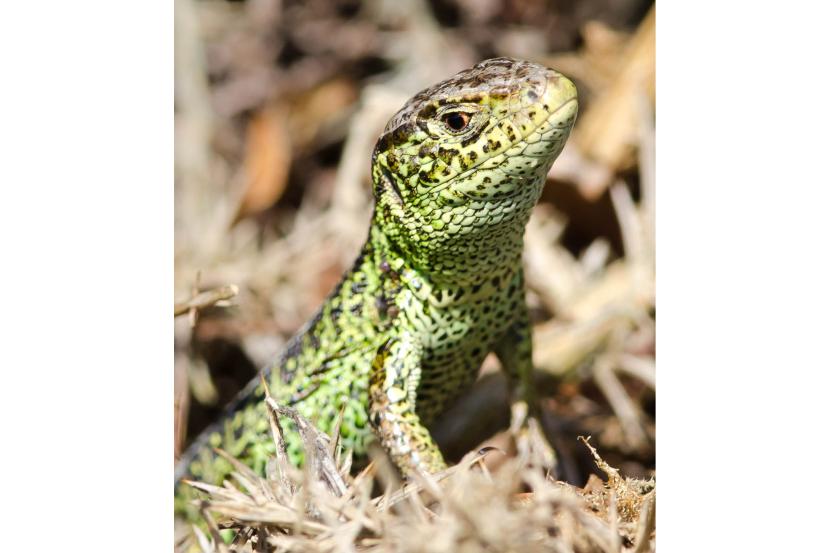
Sand lizards (Lacerta agilis) have been introduced onto one island in Scotland (Coll).
They are a European protected species (EPS) in the rest of the UK, but as they are an introduced species, they should not be regarded as an EPS in Scotland.
Grass snakes
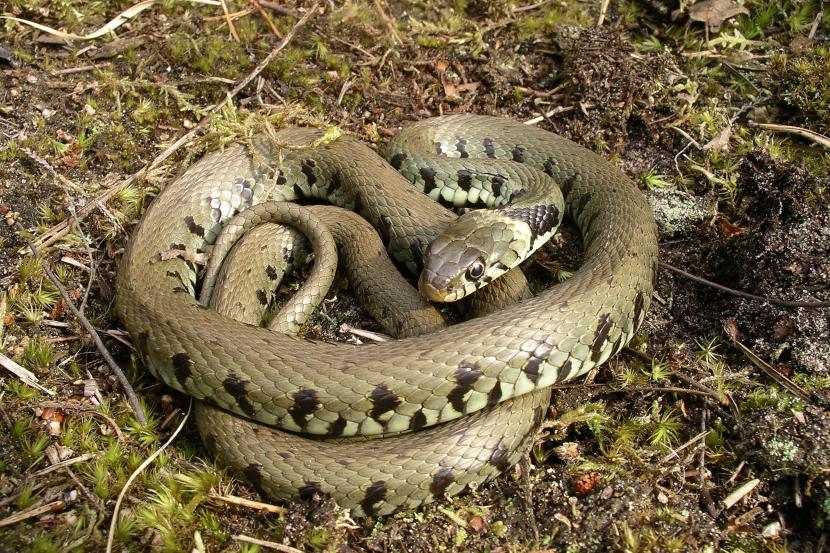
Grass snakes (Natrix natrix) are thought to be an introduced species in Scotland, with sightings mainly in Dumfries and Galloway and the Scottish Borders.
More research is needed to determine whether this species is in fact native to Scotland. Climate change could cause the northern range of this species to expand further into Scotland.
Grass snakes are often mistaken for adders, but are non-venomous and harmless to people. Grass snakes lay eggs unlike all other species of reptile in Scotland, which give birth to live young (with the exception of sand lizards which are introduced).
When threatened, this species will play dead and stick out its tongue.
Report a sighting
You should report any sighting of an amphibian or reptile to the Record Pool.
Alternatively, find out about taking part in the National Amphibian and Reptile Recording Scheme.
How can you help?
Reptiles and amphibians are both threatened groups, so it is important that we make space for these important creatures where we can. Here are some tips for ways that you could help:
- You could consider the addition of a pond to your garden to create more habitat, or encourage the growth of bug friendly plants to ensure a plentiful food supply.
- Using non-toxic methods of pest management will prevent reptiles from consuming prey that are contaminated with poison.
- Ensure that green spaces are preserved and kept as wild as possible.
- Record any reptile or amphibian sightings to the Record Pool and the NBN atlas.
- Get involved with your local amphibian and reptile group. There may even be opportunities for you to help with monitoring and surveying, or even trips to local sites!
- Help raise awareness about reptile and amphibian conservation within your school or workplace.
Further resources
For information regarding the legislation that protects our reptiles and amphibians, see Protected Species: amphibians and reptiles
For a comprehensive overview of the reptiles and amphibians of Scotland, see the book ‘The Amphibians and Reptiles of Scotland’ by Chris McInerny and Pete Minting.
For free online ID guides regarding British amphibians and reptiles, please refer to the ARG UK website.
Find out how you can take part in the National Amphibian and Reptile Monitoring Programme.
To find your local reptile and amphibian interest group, as well as additional resources, see the ARG UK website.
Find out more
Read our guidance for planners and developers on protected animals



